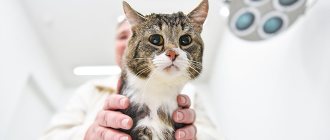Cats, like people, can suffer from various diseases, be injured or have pathologies. The animal cannot help itself, so it is important for the owner to be fully prepared and be able to help the pet in various situations. This must be done carefully, because an animal that is injured or suffering from painful sensations can become aggressive and cocky, because it does not know that they want to alleviate its condition, but it feels the additional discomfort very well.
Let's look at cases of bleeding in cats from the urethra (hematuria) and from the uterus, why they happen, and what needs to be done.
When is spotting in cats considered normal?
There are cycles and periods in a cat’s life when bloody discharge does not pose any danger.
Estrus
At the age of 6 to 12 months, a healthy female begins to estrus - a physiological hormonal cycle indicating that the animal’s body is ready for mating and bearing offspring.
At first, the pet may begin to discharge with copious mucus. After a day or two, a bloody smear appears. During this period, the cat’s behavior changes, it becomes restless, begins to “beg” the cat with loud meows, raise its tail, and actively rub against the owner’s legs.
When a cat is in heat, she bleeds from her vagina for about 5-12 days. During this time she must have time to mate. If pregnancy does not occur, then the next estrus may begin in 2.5-3 months.
Some breeds have discharge for up to 20 days. Much also depends on the age of the animal and the number of births. No intervention is required during estrus. The cat usually licks off the discharge and does not dirty the space. But at this time she may shit in the wrong place.
Pregnancy and childbirth
When a cat is pregnant with kittens, she should not have any discharge. A little mess sometimes
begins a few days before birth, especially if the female has more than 4 fetuses in her stomach.
The discharge may be clear, mixed with small blood clots, brown, but odorless and without pus. This is also a normal option and there is no need to worry.
After birth, the pet’s body will recover within 2 weeks. There is mucus and small amounts of blood discharge from the vagina. In this case, the cat does not show any signs of pain, eats well and looks completely healthy.
If after giving birth your cat's pee bleeds for more than 3 weeks, a veterinarian's consultation is also necessary.
Normally, the placenta should be delivered within 1-3 hours after birth. In rare cases, the placenta does not come out on time, and inflammation begins in the uterus. The animal's temperature rises, the genitals become red and swollen, and purulent discharge begins from the loop. In such cases, hospitalization and mechanical cleaning of the uterus are required .
With timely help, the female will return to normal within a few days.
Diagnostics
A history and physical examination are essential for a quick and accurate diagnosis. In the case of a critical condition of an animal, its life depends on the speed of diagnosis and initiation of adequate treatment.
Your veterinarian may also recommend:
- X-ray of the abdominal cavity - allows you to detect the presence of free fluid in the abdominal cavity, as well as massive formations: tumors and hematomas.
- Puncture of the abdomen using a needle and syringe to obtain a sample of fluid for testing - with hemoperitoneum, the fluid will look like blood but will not clot.
- Analysis of the resulting sample - with hemoperitoneum, the hematocrit of the liquid will be close to the hematocrit of the patient's blood.
- A complete blood test will allow you to assess the degree of anemia due to blood loss, as well as understand whether the bleeding is acute or chronic.
If necessary, additional research is carried out:
- A biochemical blood test will allow you to assess the degree of damage to internal organs. Animals with recent trauma typically have elevated liver enzymes. It is also important to assess renal function.
- Coagulogram - allows you to identify blood clotting disorders.
- Ultrasound examination of the abdominal cavity - allows you to identify the presence of neoplasms in the abdominal cavity.
- CT or MRI - allow you to visualize tumors that are not accessible to ultrasound.
Before carrying out a full diagnosis, the animal’s condition must always be stabilized!
Pathological causes of bleeding from a loop in cats
Animals, just like people, suffer from various diseases. Diseases of cats, the symptom of which is bleeding from the loop:
- Endometritis . Inflammation of the uterine mucosa. The causes are hormonal imbalances or infections.
- Vaginitis . Inflammation of the vagina of an infectious nature. It is more often observed in young cats that are not yet in heat.
- Pyometra . Associated with the concentration of progesterone in the blood of the animal. The cause is most often hormonal drugs that suppress estrus (sexual desire). The disease occurs in two forms: open, when bloody-purulent discharge is observed, and closed, without discharge. The latter form is more dangerous, it leads to severe intoxication and is fraught with serious consequences, including death.
- Hydrometra and Hemometra are not separate diseases, but consequences of various pathologies. Mucus and blood accumulate in the cat's uterus. There can be many reasons: injuries, hormonal imbalances, inflammatory processes.
- Tumors . Oncological formations of the genitourinary system in animals often lead to bleeding.
In all cases when a cat bleeds from the loop due to illness, there are other symptoms. Pet
becomes lethargic, eats poorly, drinks a lot.
The cat constantly licks the sore spot, takes unusual poses when resting (shrinks, shrinks). In some cases, frequent urination is observed. With inflammation, the animal may experience pain when defecating and meow loudly before going to the toilet.
The situation is complicated by the fact that cats are very clean and it is not always possible to replace bloody or purulent discharge immediately. But the disease progresses and the pet’s condition worsens. Therefore, you should be attentive to the general behavior of the cat. You may notice blood in the tray.
Causes of bloody impurities in urine
A number of reasons can provoke inappropriate impurities:
- Bacterial infections;
- Helminthic infestations affecting the kidneys and bladder;
- Organ damage due to trauma;
- Poisoning;
- Heart diseases;
- Oncology;
Of course, in all unclear situations when it comes to a pet and its health, it is better to immediately consult a specialist. But there are times when it is simply not physically possible to quickly deliver a patient to a veterinary clinic. So what should you do if there is blood in your cat’s urine?
You might be interested in: What causes a cat's paw to swell?
Basic actions:
- Provide the animal with a quiet stay in a cozy, dry place where no one will disturb or tug at it.
- Place clean water nearby so that the cat does not have to walk far to quench its thirst.
- Feed with liquid food.
- To disinfect the urinary tract, give your pet decoctions of parsley or bearberry.
- To eliminate inflammatory processes, decoctions of horsetail and juniper will help well.
- Under no circumstances should you start giving your animal antibiotics or other medications before consulting with a specialist.
- If bleeding is heavy, ice should be used as a cold compress on the lower abdomen or sacrum.
First aid for uterine bleeding
Uterine bleeding is not a broken knee or a runny nose. In this case, self-medication is very dangerous. If you or a loved one has uterine bleeding, you should immediately consult a doctor. If the patient’s condition does not allow him to go to a medical facility, it is necessary to call an ambulance and provide first aid to the patient.
Under no circumstances!
- If there is uterine bleeding, you should not place a heating pad or other warming objects on your stomach. This can speed up inflammatory processes.
- Do not douche the vagina - this may worsen the bleeding.
- You should not take a bath, especially a hot one. And, you should also not take any medications without a doctor’s instructions.
While the ambulance is on the way, the patient should lie down and not make sudden movements. Provide the patient with bed rest and complete rest. You need to place a cushion or pillow under your feet. Place something cold on your lower abdomen, such as ice from the freezer or frozen meat previously wrapped in cloth. This will constrict the blood vessels and reduce bleeding slightly. It is necessary to provide the patient with plenty of fluids, because a person loses a lot of fluid through blood. Tea with sugar will replenish glucose reserves in the body, and rosehip decoction will increase blood clotting.
Clinical picture of the disease
What symptoms may indicate the development of uterine bleeding? First, you need to pay attention to the pet’s behavior: if she suddenly becomes lethargic, refuses food, the skin on the limbs (when palpated) is noticeably cool, and all visible mucous membranes turn pale, you need to take her to the veterinarian as quickly as possible. All these signs directly indicate insufficient blood supply.
Only in very “successful” cases can you notice streaks of blood on the root of the tail and the external genitalia of the pet. However, even in such situations you shouldn’t panic right away: perhaps it’s just postpartum discharge, and vaginal injuries are also likely. Show your pet to the veterinarian, he will prescribe the appropriate treatment.
As practice shows, in approximately 70% of cases bleeding develops according to a “moderate” principle, and symptoms increase over several days or even weeks. This is especially true for cancer diseases. The animal gradually loses its appetite, the cat loses weight, and tries to spend more time huddled in remote corners. In addition, the pet often sleeps for a long time. If nothing is done, one day she may not wake up...
We invite you to familiarize yourself with: Do-it-yourself cat house made of a cardboard box and a T-shirt, multi-level. Drawings with dimensions, step-by-step instructions with photos. Master Class
How to stop uterine bleeding with medications
Only a doctor can prescribe medications that can stop bleeding. We will describe the main medications that are used for heavy bleeding, and also consider the principles of their action.
- Etamsylate or Dicinone.
These drugs have similar principles of action. This medicine promotes the production of thromboplastin and affects the permeability of blood vessels. This leads to increased blood clotting and significantly reduces bleeding. The drug is administered intramuscularly. - Aminocaproic acid.
This drug prevents the spontaneous dissolution of blood clots, which helps to gradually reduce the intensity of bleeding. To stop uterine bleeding, the medicine can be used under strict medical supervision. Aminocaproic acid is taken orally or intravenously. - Oxytocin.
This is a well-known hormonal medicine that is used during childbirth to stimulate muscle contractions of the uterus. Oxytocin is administered intravenously with glucose, and due to contractions of muscle tone, bleeding stops. However, extreme caution should be exercised when taking this medication - it has many contraindications. - Vikasol (vitamin K).
A lack of vitamin K leads to poor blood clotting, so Vikasol is used to compensate for the lack of this vitamin. But this medicine is difficult to use in emergency measures to stop bleeding, because the effect of taking the drug does not occur earlier than after 10 hours. Vikasol is often prescribed to people who have a tendency to bleed heavily. - Calcium gluconate.
If the body does not have enough calcium, vascular permeability increases and blood clotting worsens. Calcium gluconate is not an emergency measure to stop uterine bleeding, but it can be used as a medicine to improve the condition of blood vessels.
Care, maintenance and treatment of your pet
In order for treatment measures to bring positive results more quickly, owners need to provide the cat with proper care:
- Provide a secluded place for the animal, put a disposable sheet on the bed and change it regularly when it gets dirty.
- The room where the sick cat is located must be warm and free of drafts, and it must be ventilated regularly.
- During treatment, it is forbidden to let your pet go outside; its communication with other pets should be limited.
- The cat must have constant access to drinking water. If the animal refuses to drink or is too weak, you need to give it water yourself using a syringe, after removing the needle.
- During the illness, the animal should receive nutritious and easily digestible food. These can be meat broths, to which chopped meat, fermented milk products, cereals and vegetables are added in small quantities. On the advice of a veterinarian, you can purchase special medicated food so that the animal gains strength faster.
To protect your pet from diseases that lead to bleeding, you must adhere to the following preventive measures:
- If the cat is not intended for breeding, it makes sense to sterilize the pet. This will protect her from many diseases that occur in the genitourinary system. After the procedure, the cat should be regularly shown to the veterinarian for an ultrasound, this will help to better monitor the animal’s health.
- Get all necessary vaccinations and antihelminthic treatment in a timely manner to maintain the body's defenses.
- For mating, choose a healthy male cat; the owners of the male must document this.
- When giving birth to a cat, use sterile consumables and thoroughly treat your hands with antiseptics.
- If any unusual discharge occurs, you should take your cat to the veterinarian as soon as possible.
The measures described above will help not only prevent the development of the disease, but also, if necessary, show the cat to a specialist as soon as possible without wasting time.
Bloody discharge accompanied by a significant deterioration in the animal’s condition is a formidable sign indicating the development of severe pathology. There is no need to try to find the cause on your own, but take the cat to the veterinary clinic as soon as possible for examination and treatment.
Animals have illnesses that resemble human ones in their causes and symptoms. Discharge always signals some problems in the cat or changes in the body.
Physiological reasons
Physiological are considered reasons that cause discharge due to the characteristics of the body. Before giving birth, the female will have a plug, which is also a hard clot of mucus that comes out before giving birth. It does not bode well: it is necessary to “remove” everything unnecessary from the surface of the labia and prevent the occurrence of infections as a result of the introduction of harmful bacteria during childbirth.
After your cat gives birth, she may continue to have mucus coming from her vaginal opening and anus for some time. Color – reddish or dark brown interspersed with greenish color. The norm is 3 weeks after birth. Due to the fact that during childbirth the discharge is red (the cat has bloody discharge), after the birth of the kittens the mucus will also have a reddish tint, which will gradually turn into a brown tint and disappear.
Reference! True, during pregnancy, yellow mucus sometimes comes out - amniotic fluid.
But not everything is as simple as it seems. There are much more dangerous secretions that indicate the presence of health problems. If they are not related to pregnancy, then they are not difficult to recognize. The next step is to determine the type, cause and prescribe the correct treatment.
Dangerous diseases arise as a result of infections that enter the body through the external environment, contact with other animals and sexual intercourse.
Treatment
Treatment depends on the cause of the disease and the clinical condition of the cat. If the animal is critically ill, symptomatic treatment should be started before diagnosis is made.
Therapy may include:
- Abdominal puncture (if pressure on the diaphragm prevents breathing).
- Intravenous infusion - intravenous administration of solutions helps maintain blood pressure and improve organ and tissue perfusion, which is critical for animals in shock.
- Blood transfusion – for severe anemia.
- Pressure bandage on the abdomen - a bandage increases intra-abdominal pressure, which helps slow down or stop bleeding.
- Oxygen therapy is necessary for animals with large blood loss, especially in the early stages of treatment.
- Pain relief – reduces stress and improves the condition of patients.
- The purpose of vitamin K is for coagulopathies caused by poisoning with rat poison and other anticoagulants.
- Emergency diagnostic surgery - if there is a tumor in the abdominal cavity, or bleeding (with normal blood clotting) does not stop, despite treatment.
How to help your pet
Loving owners always strive to help their pet. Whatever the methods, they must first of all be safe. If a cat is in heat, you need to encourage her natural urges and find a cat to breed. If you really don’t want your pet to have offspring, then you can “bring her back to her senses” with the help of special medications. For example, a special ointment that is applied to the nose every day. The animal will quickly return to its usual behavior and stop meowing loudly and chasing its owners.
Reference! If the discharge is not associated with estrus, then the best thing the owner can do is take the cat to the veterinarian, or call him at home (but if the disease is serious, then transportation to the clinic will be required).
The above diseases, after reading, should lead to the conclusion that the discharge indicates serious and dangerous diseases. Therefore, it is almost impossible to help your pet at home. Loss of appetite, baldness, deterioration in general condition and other dangerous symptoms cannot be “removed” on your own.
Other predisposing factors
What other causes of intrauterine bleeding can be identified? Do not forget about the postpartum period - perhaps this is the most dangerous time. Perhaps the birth was difficult, the cat received some kind of injury, the consequences of which made themselves felt. There is a possibility that a mummified fetus remained in the uterus, which injured the wall of the organ. Also, one should not exclude the possibility of pathogenic and conditionally pathogenic microflora entering the uterus, which happens quite often after childbirth.
Finally, very often (although less frequently dogs) suffer from cancer.
Uterine bleeding in a cat may well be a consequence of proliferation or destruction. During the growth period, the neoplasm is extremely aggressive towards surrounding tissues, destroying and “distorting” them. Damage to large blood vessels is possible.
Hematuria: causes and first aid
If a cat is bleeding from the urethra, this may indicate the presence of serious pathologies in the pet’s body that will require long-term treatment and rehabilitation.
First you need to find out the reason for its appearance. This can be done by collecting the animal’s urine for analysis and, first of all, confirming the presence of red blood cells in it.
How to do it correctly:
- The tray where the cat goes to the toilet should be thoroughly washed with hot water. There is no need to use any household chemicals, since it is quite difficult to rinse them out, and when mixed with the sample for analysis, it will spoil the indicators and prevent the picture of the disease from being correctly interpreted.
- The filler should be removed from the tray; the maximum that can be used is sea pebbles, also carefully washed with ordinary running water.
- The collected sample is transferred to a sterile container and taken to the veterinary laboratory. This should happen no more than 4 hours after collection.
- The animal's last meal should be 6 hours before the test, so as not to blur the true picture.
This is interesting: What to do if a cat has mammary cancer?
What kind of bleeding can there be?
Although the cause of blood loss is always a violation of the integrity of the vessel wall, the bleeding itself can be very different.
Table: classification of bleeding
| Classification sign | Types of bleeding |
| Type of damaged vessel |
|
| Time of bleeding |
|
| Direction of blood flow |
|
With external bleeding, blood flows freely outward
At the same time, no matter how the blood loss occurs (drop by drop, in a thin stream or in a pulsating fountain), external bleeding is almost always clearly visible, while internal bleeding is never visible. And this makes internal bleeding especially dangerous.
Overt and hidden internal bleeding
Although internal bleeding itself cannot be seen with the naked eye, some types of it are still characterized by certain external manifestations. This type of bleeding is called overt internal bleeding.
Table: external signs of obvious internal bleeding
| Type of obvious internal bleeding | External signs |
| Bleeding in the esophagus | Vomiting blood (blood in the vomit is scarlet) |
| Stomach bleeding | Coagulated dark red or brown blood (“coffee grounds”) in vomit |
| Intestinal bleeding | Vomiting "coffee grounds" (for bleeding in the small intestine) and/or stools that are dark bloody or resemble "coffee grounds" (for bleeding in the lower intestine) |
| Pulmonary hemorrhage | Cough with frothy, bloody sputum |
| Uterine bleeding | Bloody discharge from the loop |
| Kidney bleeding | Blood in any urine |
Any caring owner will definitely pay attention to such alarming manifestations, which means that the animal’s chances of not bleeding to death are quite high. The situation is much worse with so-called hidden internal bleeding.
Hidden internal bleeding
Hidden internal bleeding does not have any immediate manifestations visible to the eye. This is because they occur inside body cavities (such as the abdominal cavity) or organs (such as the spleen) that have no communication with the outside environment. However, such bleeding has certain indirect signs:
- dyspnea;
- pallor of the mucous membranes;
- sudden fatigue;
- lack of appetite;
- weight loss;
- apathy and drowsiness;
- rapidly increasing abdominal volume;
- bruises under the skin.
Pale mucous membranes of the animal (best seen on the inside of the lips and gums) may be a sign of hidden internal bleeding
And the owner must be truly attentive to his pet in order to recognize warning signs in time and help the animal save its life.











